Papua New Guinea Liveaboard Diving
Price upon request
Dive Papua New Guinea with Golden Dawn
Overview | Eastern Fields/Coral Sea | Milne Bay | North Coast PNG | Kavieng
Golden Dawn is a beautiful 80 ft dive boat outfitted to accommodate 10 guests in 5 air conditioned cabins, some with ensuite facilities. Taking advantage of the best weather and diving conditions in Papua New Guinea, MV Golden Dawn changes location throughout the year, offering a unique and diverse diving experience.
Golden Dawn's annual schedule of dive destinations moves to different locations around Papua New Guinea to take advantage of the best weather conditions in the different areas. This enables her to offer the kind of varied and exciting diving that is consistent with PNG's reputation.
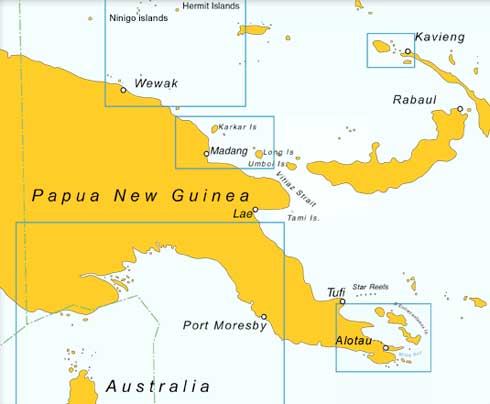
From July through September Golden Dawn's 10-day cruises from Madang and Wewak take the divers to Hermit, Ninigo and Bagabag Islands where surprises such as manta rays, turtles, and on ocassion Orcas have been spotted. "Muck Diving" is also an opportunity to see some of the rare species.
To kick the adrenline into overdrive, Golden Dawn's captain, Craig De Wit, has added some shark feeding that is truly a spectacular event. Our experiences at all of these sites have provided priceless memories.
From November through to December and April through to May, Golden Dawn heads south to the Coral Sea... prime time for this area. On these cruises, you will find the waters of the barrier reef system around Port Moresby teeming with beautiful flora and fauna to satisfy the keenest sports diver or the most dedicated underwater photographer, with Mantas, Sharks and Turtles.
During March, June and October, Golden Dawn goes hunting mantas in the southern Milne Bay area.
Notes
This dive cruise can be incorporated into a Symbiosis tailor made holiday to Papua New Guinea that can be adapted and tailored to meet your dates, preferences and passions. Please contact one of our bespoke holiday planners to create the ideal itinerary for you.
Eastern Fields/Coral Sea
The Eastern fields/Coral Sea - November through to December and April through to May... prime time for this area. On these cruises, you will find the waters of the barrier reef system around Port Moresby teeming with beautiful flora and fauna to satisfy the keenest sports diver or the most dedicated underwater photographer, with Mantas, Sharks and Turtles.
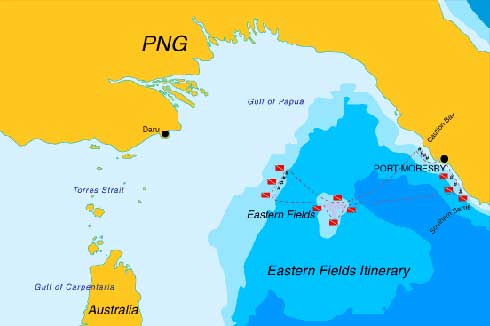
Divers have encountered the rare Great hammerhead as well as his smaller Scalloped brothers and Whale Sharks are sighted annually as far in as the capital's main harbour! The more exotic treats include the Lacy Scorpion fish (Rhinopias aphanes and his rarer brother R. fondoza), Leaf Scorpion fish, Stone and False Stonefish, Crocodile fish, Pygmy sea horse and Tasselled Wobbegongs,
Epaulette and Leopard Sharks. The waters here are moderate in visibility but excellent for close-up photography.
Further offshore, in the clear waters of the Coral Sea, Golden Dawn is pioneering dive operations at the spectacular Eastern Fields, a submerged atoll rising from over 4,000 ft /1,200 mtrs and covering some 400 square miles. Most of this reef system is still unexplored - suffice it to say that over 200ft / 70mtr visibility has been experienced. Eastern Fields is located 90 nautical miles south west of Port Moresby in the northern reaches of the Coral Sea.
This area of the Coral Sea is rarely troubled by the cyclone's passing by on their way to the southern latitudes leaving the coral in pristine condition. Being close to the eastern approaches of the Torres Strait (the name for the passage of water between Australia and Papua New Guinea) gives this area the currents that attract the pelagic marine life such as schools of large Dog Tooth, Yellow fin, Blue fin Tuna, Spanish Mackerel and Wahoo. Eagle and Manta rays can be found patrolling the walls, as well as schools of horse eye jacks in their balling formations and schools of spiralling Barracuda.
On shark dives, Grey reef Sharks and their elegant brothers the Silver tips are frequently encountered. The Great and Scalloped hammerhead shark will often make an appearance when you least expect it! You will enjoy dive sites like "Carls Ultimate", where the marine life is so rich and diverse that it is not uncommon for divers to do 12 dives and still ask for more. The small and the unexpected should not be left out, with species of Nudibranch and Flat worm we have not been able to identify as yet! Many different types of Shrimp Goby, Blennies and clouds of Anthias and Fusiliers are to be found while diving.
The Coral Sea trip is not recommended for the beginner diver or those who are prone to seasickness as it is all open ocean diving.
Milne Bay
During March, June and October, Golden Dawn goes hunting mantas in the southern Milne Bay area.
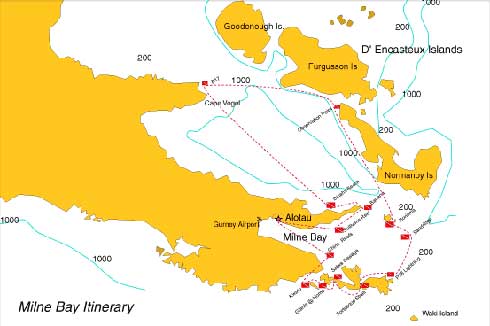 This is not the usual "milk run" originally pioneered and made famous by Bob and Dinah Halstead*, though a few of the sites are covered on route to Samarai Island region. There are a number of varied dives on this schedule, strong current to 'muck' dives, though the sensation are the mantas at "Giants at Home". Here in shallow water, large coral boulders, with a healthy cover of soft corals are scattered over a sandy bottom. Big sweet lips, groupers, Hump Headed Parrotfish and even Dugong make an appearance.
This is not the usual "milk run" originally pioneered and made famous by Bob and Dinah Halstead*, though a few of the sites are covered on route to Samarai Island region. There are a number of varied dives on this schedule, strong current to 'muck' dives, though the sensation are the mantas at "Giants at Home". Here in shallow water, large coral boulders, with a healthy cover of soft corals are scattered over a sandy bottom. Big sweet lips, groupers, Hump Headed Parrotfish and even Dugong make an appearance.
The giant mantas come in to be cleaned by the wrasse on the large bommies. There are at least a dozen individuals in the 9'-12' (3-4m) range and you can get so close you can fill a fish eye lens.
Golden Dawn will normally spend some considerable time at this location so that everybody will get the opportunity to get close to these magnificent creatures. The visibility here is modest as it is full of plankton and that is what mantas like best.
North Coast PNG
During June through September, Golden Dawn offers Northern Papua New Guinea, running from Madang and Wewak.
Northern Papua New Guinea diving is best described as diving the "Cocus of PNG" with the main theme being big animals. While Eastern Fields trips will give you more shark sightings with pristine reefs, Milne Bay the large Mantas and 'muck' macro, Madang a good mixture of everything plus the "Hammers", trips departing Wewak for the Ninigo and Hermits definitely produce the biggest variety in big animals. Common sightings of Grey Reef Sharks, some Silver Tips and then a plethora of rays, which include the Eagle Rays, Cow Rays, Mobula Rays, and Manta Rays! A big hit is the swim with a pod of a thousand Dolphins in Dolphin Pass (for want of a better name). Another memorable site "The Dive" has thousands of pelagic fish against a dramatic back drop of reef.
There is also normally a dive stop at one or two WWII shipwrecks that are near the island of Kairuru. The testimony of time has changed these wrecks into large artificial reefs, providing homes for an abundance of marine life. Many species of scorpion fish can be found camouflaged against the hull; ghost pipefish and frogfish have also been sighted. Visibility at most sights is superb at 100-150' (30 - 45m) while at others its marginal at 40 - 60' (12 - 20m) - due to their locations, eg near Wewak or inner lagoon. Water temperature is wonderful at around 82 - 84 deg F (28 - 30 deg C) so skin suites or 3mm suites are more than adequate. There are three main Island groups visited and all three are different in geography and equally stunning, the people at inhabited islands are very friendly and the beaches visited are picture post card material.
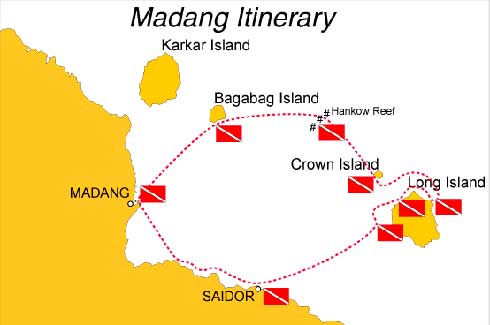
Madang departures go to the islands some 70nm east, the coastline and surrounding islands offer some truly great diving. The islands of Bagabag, Crown and Long with their tall volcanic peaks and their superb fringing reefs, one newly discovered site "Julien's Reef" is on par with "Carl's Ultimate", rich with corals and large schools of barracuda and mackerel and other pelagic species. The number of hammerhead sightings on this itinerary have been numerous and tiger sharks have also made appearances. The night anchorage's offer truly classic Milne Bay type muck dives in the rich volcanic sand. Snake eels, inimicus, turtles and cuttle fish are commonly sighted.
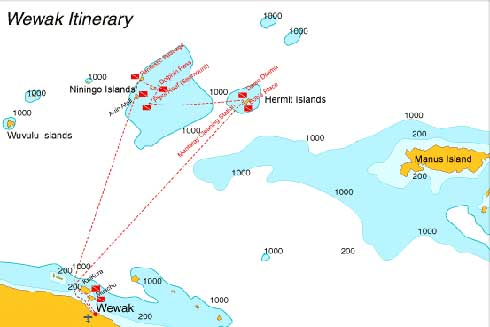 Further north on the Wewak run we start with some coastal wreck diving near the islands of Muschu and Kairuru. Here the Japanese were surprised attacked during WW2 and a number of their armed merchant fleet were sunk. The testimony of time has changed these wrecks into large artificial reefs, providing homes for an abundance of marine life. Many species of scorpion fish can be found camouflaged against the hull ghost pipefish and frogfish have been sighted. You could easily spend a few days on these wrecks, while the vis can be modest sometimes it is around 100' (30m).
Further north on the Wewak run we start with some coastal wreck diving near the islands of Muschu and Kairuru. Here the Japanese were surprised attacked during WW2 and a number of their armed merchant fleet were sunk. The testimony of time has changed these wrecks into large artificial reefs, providing homes for an abundance of marine life. Many species of scorpion fish can be found camouflaged against the hull ghost pipefish and frogfish have been sighted. You could easily spend a few days on these wrecks, while the vis can be modest sometimes it is around 100' (30m).
Continuing north some 120nm towards the equator the outer islands of Ninigo and Hermits provide true atoll style diving with visibility exceeding 130' (40m) and the seas are calm and warm. On this part of the journey there are frequent encounters with eagle rays, mantas, devil, marble and cow rays, turtles and a huge pod of friendly dolphins. One of the dive locations in this region, "The Dive", is another memorable site with pelagic fish life in the thousands against a dramatic back drop of reef in visibility that is in the region of 200' (60m).
Kavieng
Diving in Kavieng presents yet another diversely different dive destination in PNG.
Known for it's pelagic splendor the strong incoming currents that act as magnets to the schools of trevally, barracuda, grey reef sharks, eagle rays and reef fish. During outgoing tides, low lying channel islands clad in mangroves, provide havens for juvenile fish species and other exquisite macro critters.
These islands also provide excellent calm safe anchorage's for the Golden Dawn.
A number of world class wrecks are dived, remnants to the 2nd WW. For example in Three Island Harbour, there is the Sanko Maru and the Japanese Mini submarine. These wrecks are some of the best night wreck dives that skipper, Craig de Wit, says he has ever experienced. A newer wreck, the "Der Yang" at Echuca Patch is a fantastic site for photographic and video enthusiasts with the schools of barracuda circling above the wreck in blue water.
The deep water west from New Hanover is an oceanic passage for large creatures such as orcas and sperm whales and we have at times managed to swim with these giants of the sea.
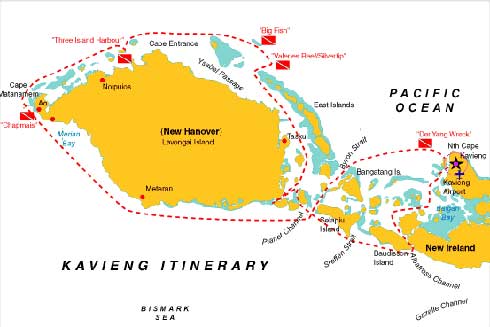
The Golden Dawn
Boat Information
- Name : Golden Dawn
- Destination : NewGuinea
- Seasons : Year round
- Capacity : 10 divers (max no. guests)
About the cabins
- Cabin Facilities Room : 5 double beds, 5 twin sharing, Showers & toilets - 2 ensuite, 3 shared,TV, Video Recorder (NTSC & PAL), Stereo.
- Electricity : 220V
- Sockets:
Technical Data
- Length x Beam : 80ft long- 22ft wide
- Engines :
- Max speed : 12 kts
- Cruising speed : 10 Knots
- Navigation equipment : VHF, HF, SSB radar, autopilot, GPS, satellite telephone.
- Communications equipment :
- Fuel capacity/range : 9000 Litre
- Fresh water capacity : 7500 Litre Desalinator
Further Information
- Dive Entry :
- Life jackets :
- Life rafts :
- Boat Crew : Crew has separate facilities.
Golden Dawn is a beautiful 80 ft dive boat outfitted to accommodate 10 guests in 5 air conditioned cabins, some with ensuite facilities. Taking advantage of the best weather and diving conditions in Papua New Guinea, MV Golden Dawn changes location throughout the year, offering a unique and diverse diving experience.
* NOTE. Prices indicated on this website are shown as a guideline only and may be subject to currency fluctuations, banking fees and other changes outside our control. Pricing information is available in
other currencies.
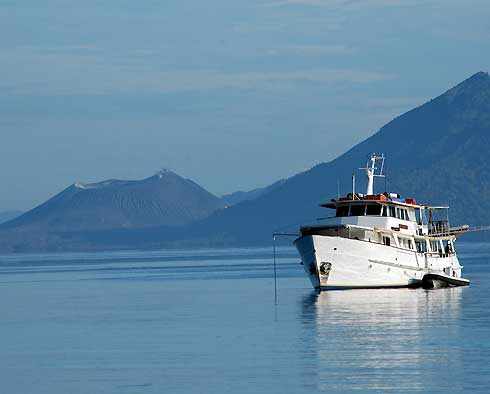

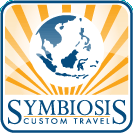

 This is not the usual "milk run" originally pioneered and made famous by Bob and Dinah Halstead*, though a few of the sites are covered on route to Samarai Island region. There are a number of varied dives on this schedule, strong current to 'muck' dives, though the sensation are the mantas at "Giants at Home". Here in shallow water, large coral boulders, with a healthy cover of soft corals are scattered over a sandy bottom. Big sweet lips, groupers, Hump Headed Parrotfish and even Dugong make an appearance.
This is not the usual "milk run" originally pioneered and made famous by Bob and Dinah Halstead*, though a few of the sites are covered on route to Samarai Island region. There are a number of varied dives on this schedule, strong current to 'muck' dives, though the sensation are the mantas at "Giants at Home". Here in shallow water, large coral boulders, with a healthy cover of soft corals are scattered over a sandy bottom. Big sweet lips, groupers, Hump Headed Parrotfish and even Dugong make an appearance.
 Further north on the Wewak run we start with some coastal wreck diving near the islands of Muschu and Kairuru. Here the Japanese were surprised attacked during WW2 and a number of their armed merchant fleet were sunk. The testimony of time has changed these wrecks into large artificial reefs, providing homes for an abundance of marine life. Many species of scorpion fish can be found camouflaged against the hull ghost pipefish and frogfish have been sighted. You could easily spend a few days on these wrecks, while the vis can be modest sometimes it is around 100' (30m).
Further north on the Wewak run we start with some coastal wreck diving near the islands of Muschu and Kairuru. Here the Japanese were surprised attacked during WW2 and a number of their armed merchant fleet were sunk. The testimony of time has changed these wrecks into large artificial reefs, providing homes for an abundance of marine life. Many species of scorpion fish can be found camouflaged against the hull ghost pipefish and frogfish have been sighted. You could easily spend a few days on these wrecks, while the vis can be modest sometimes it is around 100' (30m).

